人教版英语三年级下册期末重点句型复习课件(共32张PPT)
文档属性
| 名称 | 人教版英语三年级下册期末重点句型复习课件(共32张PPT) |

|
|
| 格式 | pptx | ||
| 文件大小 | 1.0MB | ||
| 资源类型 | 试卷 | ||
| 版本资源 | 人教版(PEP) | ||
| 科目 | 英语 | ||
| 更新时间 | 2025-06-08 09:13:32 | ||
图片预览

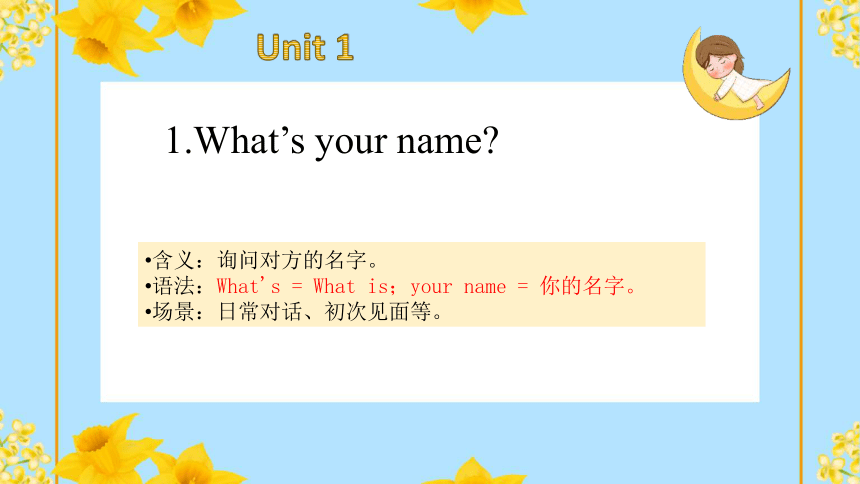
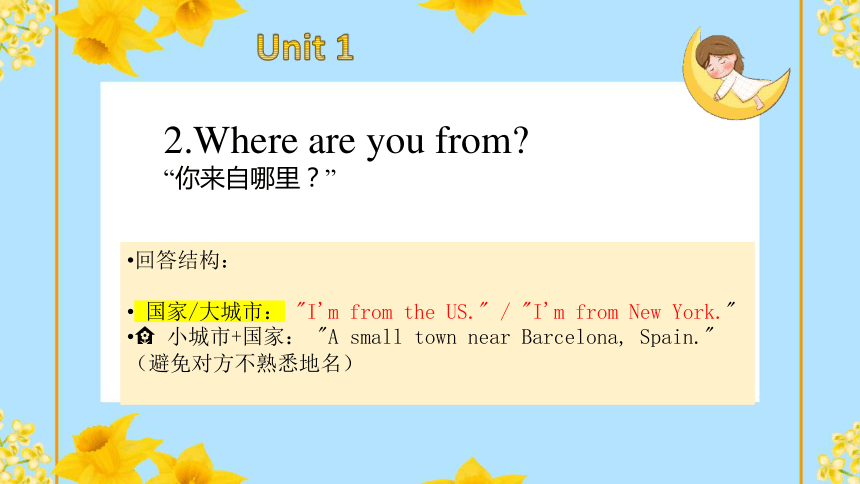
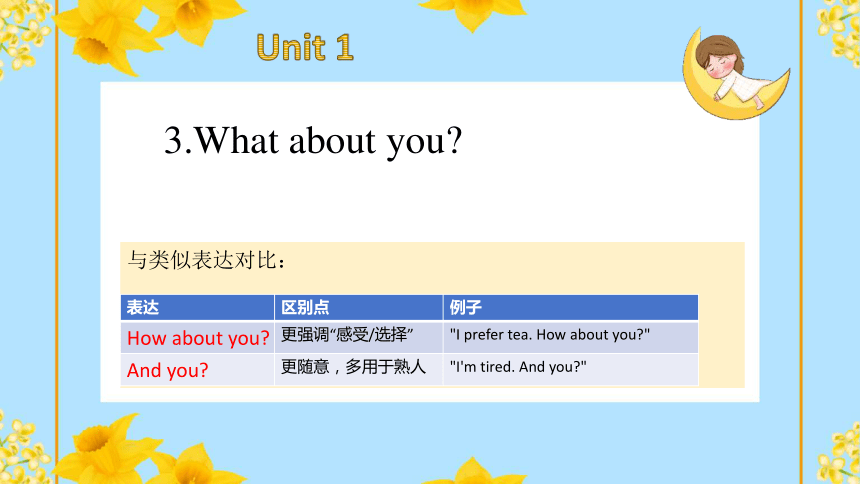
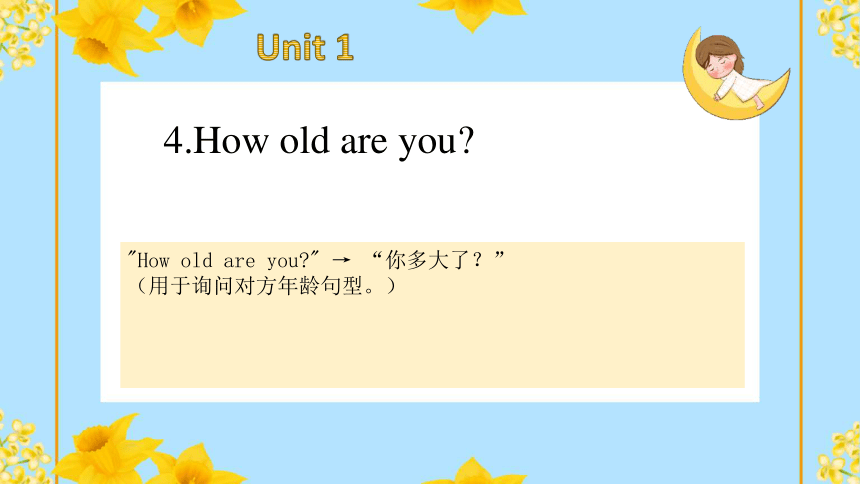
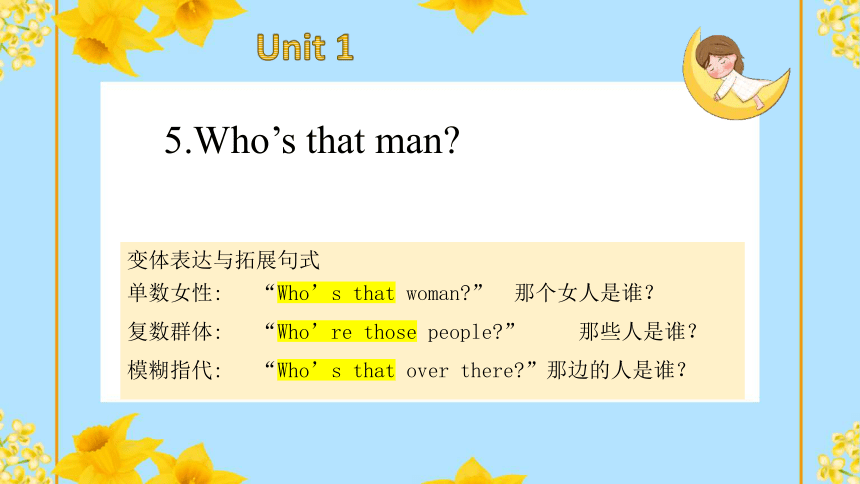
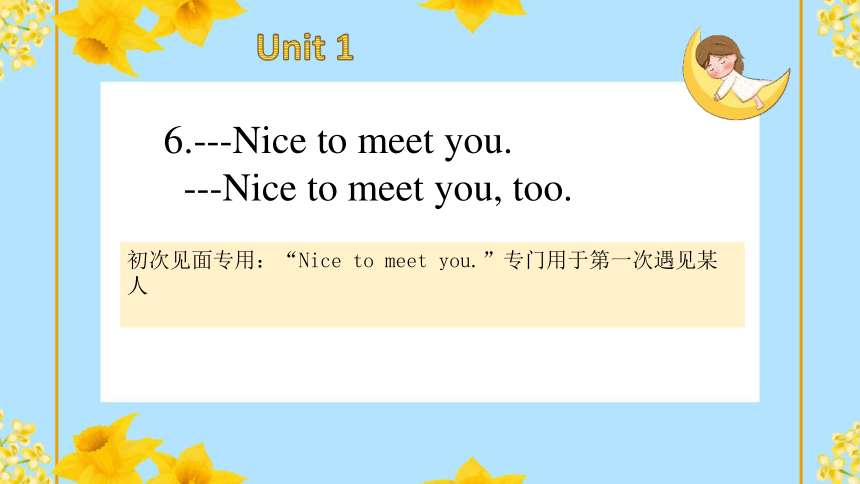
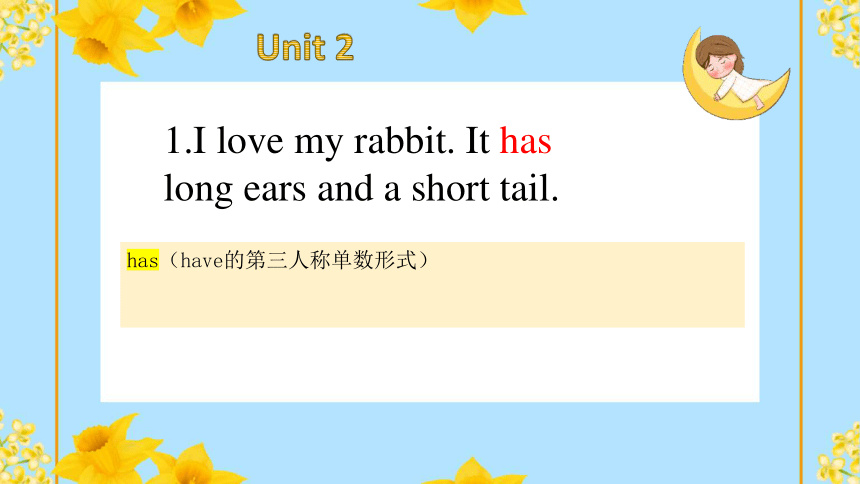
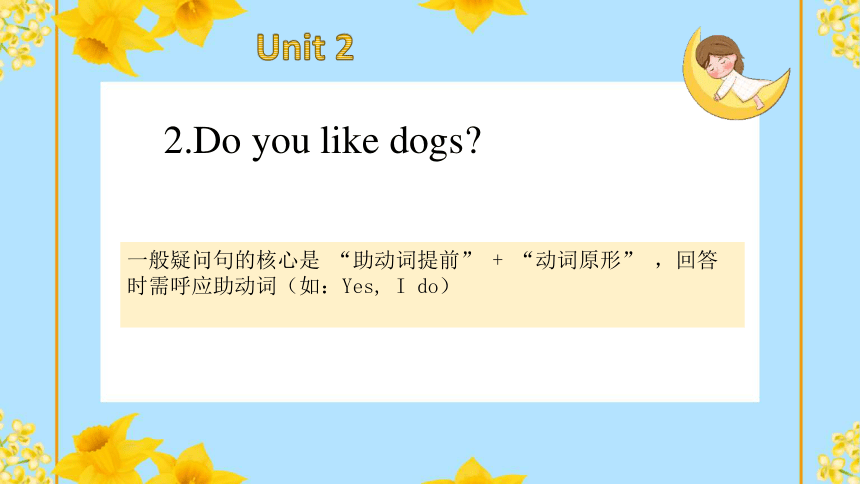

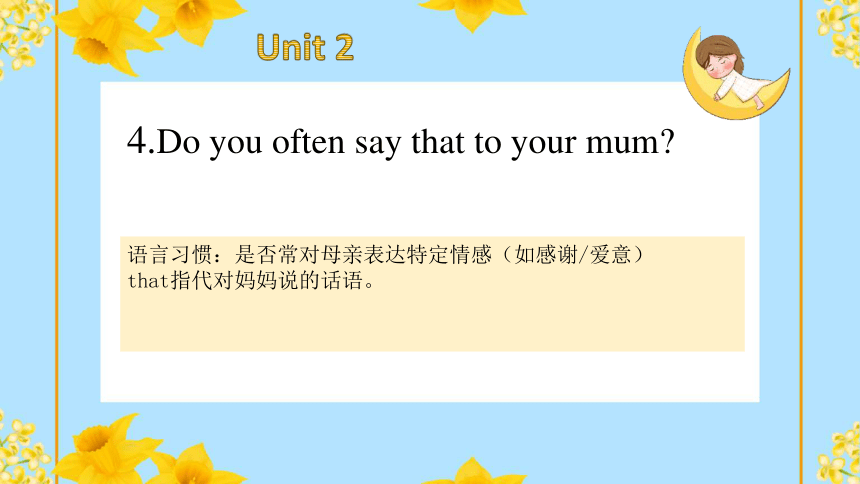
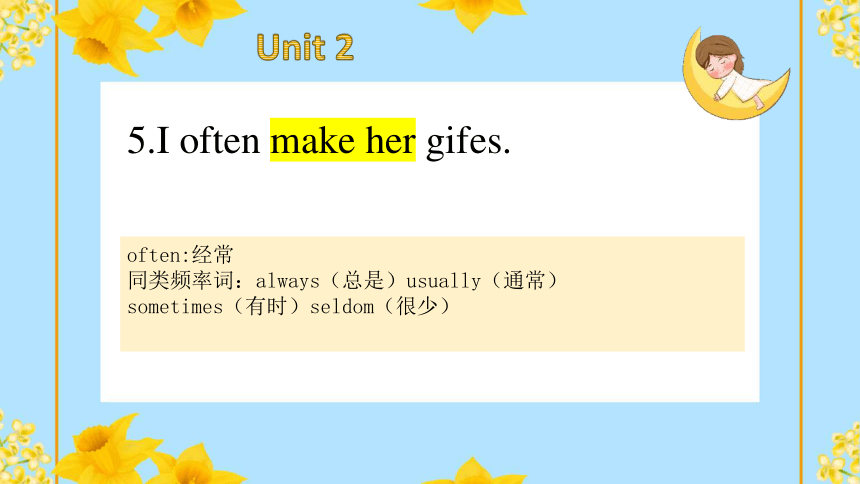
文档简介
(共32张PPT)
PEP人教版三年级英语下册
期末总复习
重点句型复习
Unit 1
1.What’s your name
含义:询问对方的名字。
语法:What's = What is;your name = 你的名字。
场景:日常对话、初次见面等。
Unit 1
2.Where are you from
“你来自哪里?”
回答结构:
国家/大城市: "I'm from the US." / "I'm from New York."
小城市+国家: "A small town near Barcelona, Spain."(避免对方不熟悉地名)
Unit 1
3.What about you
与类似表达对比:
表达 区别点 例子
How about you 更强调“感受/选择” "I prefer tea. How about you "
And you 更随意,多用于熟人 "I'm tired. And you "
Unit 1
4.How old are you
"How old are you " → “你多大了?”
(用于询问对方年龄句型。)
Unit 1
5.Who’s that man
变体表达与拓展句式
单数女性: “Who’s that woman ” 那个女人是谁?
复数群体: “Who’re those people ” 那些人是谁?
模糊指代: “Who’s that over there ”那边的人是谁?
Unit 1
6.---Nice to meet you.
---Nice to meet you, too.
初次见面专用:“Nice to meet you.”专门用于第一次遇见某人
Unit 2
1.I love my rabbit. It has long ears and a short tail.
has(have的第三人称单数形式)
Unit 2
2.Do you like dogs
一般疑问句的核心是 “助动词提前” + “动词原形” ,回答时需呼应助动词(如:Yes, I do)
Unit 2
3.Dogs are friendly.They can help us too.
规则总结:
谁(主语) + 是(系动词) + 什么样(表语)
例:Cats (谁) are (是) cute (什么样).
Unit 2
4.Do you often say that to your mum
语言习惯:是否常对母亲表达特定情感(如感谢/爱意)
that指代对妈妈说的话语。
Unit 2
5.I often make her gifes.
often:经常
同类频率词:always(总是)usually(通常)
sometimes(有时)seldom(很少)
Unit 2
6.Let’s sing and dance.
Let’s=let us
Unit 3
1.Excuse me.Can I use your eraser,please
文化规则:
眼神接触:说 Excuse me 时需注视对方
请求 → 对方同意(Sure/No problem) → 使用后归还 → 道谢(Thanks a lot!)
Unit 3
2.What’s this
this 指代眼前单数物体
仅用于单数,指空间/心理距离近的事物
( 手指触碰的物体 / 刚提及的话题)
Unit 3
3.What are these
these 指代近处多个事物
适用情境:
指桌上多个物品问:What are these (这些是什么?)
看到陌生植物:What are these purple flowers (这些紫色的花是什么?)
购物时指货架商品( these 需配合手势指向近处物体)
Unit 3
4.I smell with my nose.
smell 闻起来(感官动词)
日常生活例子:
Fresh bread smells amazing.(新鲜面包香气扑鼻)
The bathroom smells bad.(浴室有异味)
The air smells clean after rain.(雨后空气闻着清新)
Unit 3
5.I taste with my tongue.
taste 尝起来(感官动词:描述食物/饮料的味道特性)
日常生活例子:
例句:
The lemon tastes sour.(柠檬尝起来很酸)
This cake tastes sweet.(蛋糕味道甜美)
Unit 3
6.I see and hear in class.
日常生活场景
I see raindrops on the window.(我看见窗上的雨点)
We hear the bell ringing every hour.(我们每小时都听到钟声)
Can you hear me clearly (能听清我说话吗?)
Unit 4
1.Breakfast time!
(It is) + 时段名词 + ! ---功能:宣布事件/催促行动
日常宣布用餐: "Breakfast time! Come to the table!"
(早餐好了!快上桌!)
"Coffee’s ready~Breakfast time!"
(咖啡好了~吃早餐啦!)
Unit 4
2.I’d like some bread and eggs, please!
I’d like + some + [食物名] + please!
功能:礼貌点餐/提出饮食需求
Unit 4
3.Here you are!
倒装句(正常语序:You are here → 倒装突出 here 的位置信息)
功能:礼貌地递物品 / 确认对方位置
Unit 4
4.Would you like some rice and meat
(请对方接受食物/饮品)
接受回应句式:Yes, please!/I’d love some./Just a little, thanks.
拒绝回应句式:No, thank you./
Unit 4
5.Have some vegetables too.They’re good.
祈使句:Have some vegetables too.
“Try the chicken, and have some broccoli too. It’s good for your bones!”
(尝尝鸡肉,再来点西兰花——对骨骼好!)
Unit 5
1.Wow!So many toys!
通过程度强化(so) + 数量词(many)表达强烈视觉冲击
进玩具店时:
Child: "Wow! So many LEGOs!"
(哇!这么多乐高!)
收到礼物时:
"Wow! So many toy cars! Thank you!"
Unit 5
2.You can keep it!
允许对方永久保留某物(隐含赠送意图)
分享小物:
A: "Your lip balm saved me!"
B: "You can keep it! I have three more."
Unit 5
3.Do you have any old school things
典型校园怀旧物
学习类:textbooks(课本), report cards(成绩单)
活动类:sports ribbons(运动绶带), theater programs(话剧节目单)
时代标志:walkmans(随身听), floppy disks(软盘)
Unit 5
4.Where is my animal book
寻找某物品句型:Where is...
Where is my toy car
Unit 5
5. Is it on the shelf
is引导的一般疑问句
介词扩展练习:
内部: Is it in the drawer
下方: Is it under the chair
旁边: Is it beside the painting
Unit 6
1.How many books do we have
How many... 疑问句(询问可数名词数量)
例子:
: “How many picture books do we have Let’s donate duplicates.”我们有多少绘本?重复的捐掉吧。)
: “We have 37! I counted yesterday.”
Unit 6
2.How much is this bag
How much... 疑问句(询问专指价格或不可数名词量)
例子:
: “How much is the pencil
: It’s two yuan.
PEP人教版三年级英语下册
Goodbye!
PEP人教版三年级英语下册
期末总复习
重点句型复习
Unit 1
1.What’s your name
含义:询问对方的名字。
语法:What's = What is;your name = 你的名字。
场景:日常对话、初次见面等。
Unit 1
2.Where are you from
“你来自哪里?”
回答结构:
国家/大城市: "I'm from the US." / "I'm from New York."
小城市+国家: "A small town near Barcelona, Spain."(避免对方不熟悉地名)
Unit 1
3.What about you
与类似表达对比:
表达 区别点 例子
How about you 更强调“感受/选择” "I prefer tea. How about you "
And you 更随意,多用于熟人 "I'm tired. And you "
Unit 1
4.How old are you
"How old are you " → “你多大了?”
(用于询问对方年龄句型。)
Unit 1
5.Who’s that man
变体表达与拓展句式
单数女性: “Who’s that woman ” 那个女人是谁?
复数群体: “Who’re those people ” 那些人是谁?
模糊指代: “Who’s that over there ”那边的人是谁?
Unit 1
6.---Nice to meet you.
---Nice to meet you, too.
初次见面专用:“Nice to meet you.”专门用于第一次遇见某人
Unit 2
1.I love my rabbit. It has long ears and a short tail.
has(have的第三人称单数形式)
Unit 2
2.Do you like dogs
一般疑问句的核心是 “助动词提前” + “动词原形” ,回答时需呼应助动词(如:Yes, I do)
Unit 2
3.Dogs are friendly.They can help us too.
规则总结:
谁(主语) + 是(系动词) + 什么样(表语)
例:Cats (谁) are (是) cute (什么样).
Unit 2
4.Do you often say that to your mum
语言习惯:是否常对母亲表达特定情感(如感谢/爱意)
that指代对妈妈说的话语。
Unit 2
5.I often make her gifes.
often:经常
同类频率词:always(总是)usually(通常)
sometimes(有时)seldom(很少)
Unit 2
6.Let’s sing and dance.
Let’s=let us
Unit 3
1.Excuse me.Can I use your eraser,please
文化规则:
眼神接触:说 Excuse me 时需注视对方
请求 → 对方同意(Sure/No problem) → 使用后归还 → 道谢(Thanks a lot!)
Unit 3
2.What’s this
this 指代眼前单数物体
仅用于单数,指空间/心理距离近的事物
( 手指触碰的物体 / 刚提及的话题)
Unit 3
3.What are these
these 指代近处多个事物
适用情境:
指桌上多个物品问:What are these (这些是什么?)
看到陌生植物:What are these purple flowers (这些紫色的花是什么?)
购物时指货架商品( these 需配合手势指向近处物体)
Unit 3
4.I smell with my nose.
smell 闻起来(感官动词)
日常生活例子:
Fresh bread smells amazing.(新鲜面包香气扑鼻)
The bathroom smells bad.(浴室有异味)
The air smells clean after rain.(雨后空气闻着清新)
Unit 3
5.I taste with my tongue.
taste 尝起来(感官动词:描述食物/饮料的味道特性)
日常生活例子:
例句:
The lemon tastes sour.(柠檬尝起来很酸)
This cake tastes sweet.(蛋糕味道甜美)
Unit 3
6.I see and hear in class.
日常生活场景
I see raindrops on the window.(我看见窗上的雨点)
We hear the bell ringing every hour.(我们每小时都听到钟声)
Can you hear me clearly (能听清我说话吗?)
Unit 4
1.Breakfast time!
(It is) + 时段名词 + ! ---功能:宣布事件/催促行动
日常宣布用餐: "Breakfast time! Come to the table!"
(早餐好了!快上桌!)
"Coffee’s ready~Breakfast time!"
(咖啡好了~吃早餐啦!)
Unit 4
2.I’d like some bread and eggs, please!
I’d like + some + [食物名] + please!
功能:礼貌点餐/提出饮食需求
Unit 4
3.Here you are!
倒装句(正常语序:You are here → 倒装突出 here 的位置信息)
功能:礼貌地递物品 / 确认对方位置
Unit 4
4.Would you like some rice and meat
(请对方接受食物/饮品)
接受回应句式:Yes, please!/I’d love some./Just a little, thanks.
拒绝回应句式:No, thank you./
Unit 4
5.Have some vegetables too.They’re good.
祈使句:Have some vegetables too.
“Try the chicken, and have some broccoli too. It’s good for your bones!”
(尝尝鸡肉,再来点西兰花——对骨骼好!)
Unit 5
1.Wow!So many toys!
通过程度强化(so) + 数量词(many)表达强烈视觉冲击
进玩具店时:
Child: "Wow! So many LEGOs!"
(哇!这么多乐高!)
收到礼物时:
"Wow! So many toy cars! Thank you!"
Unit 5
2.You can keep it!
允许对方永久保留某物(隐含赠送意图)
分享小物:
A: "Your lip balm saved me!"
B: "You can keep it! I have three more."
Unit 5
3.Do you have any old school things
典型校园怀旧物
学习类:textbooks(课本), report cards(成绩单)
活动类:sports ribbons(运动绶带), theater programs(话剧节目单)
时代标志:walkmans(随身听), floppy disks(软盘)
Unit 5
4.Where is my animal book
寻找某物品句型:Where is...
Where is my toy car
Unit 5
5. Is it on the shelf
is引导的一般疑问句
介词扩展练习:
内部: Is it in the drawer
下方: Is it under the chair
旁边: Is it beside the painting
Unit 6
1.How many books do we have
How many... 疑问句(询问可数名词数量)
例子:
: “How many picture books do we have Let’s donate duplicates.”我们有多少绘本?重复的捐掉吧。)
: “We have 37! I counted yesterday.”
Unit 6
2.How much is this bag
How much... 疑问句(询问专指价格或不可数名词量)
例子:
: “How much is the pencil
: It’s two yuan.
PEP人教版三年级英语下册
Goodbye!
同课章节目录
